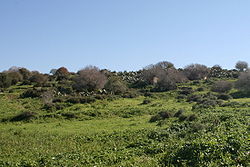Hawsha
هوشة Husha, Khirbat Husha, Khǔrbet Hǔsheh | |
|---|---|
 Remains of Hawsha in the winter of 2010 | |
| Etymology: Joshua[1] or Kh. Husheh; "The ruin of Husheh",[2] | |
A series of historical maps of the area around Hawsha (click the buttons) | |
Location within Mandatory Palestine | |
| Coordinates: 32°47′36″N 35°08′41″E / 32.79333°N 35.14472°E | |
| Palestine grid | 163/244 |
| Geopolitical entity | Mandatory Palestine |
| Subdistrict | Haifa |
| Date of depopulation | mid-April, 1948[3] |
| Area | |
| • Total | 901 dunams (90.1 ha or 223 acres) |
| Population (1945)[6] | |
| • Total | 400 |
| Cause(s) of depopulation | Military assault by Yishuv forces |
Hawsha (Arabic: هوشة, Hǔsheh, also Husha) was an Arab village established in 1880 by Maghrebi immigrants of Algerian origin, built on ruins of the ancient Jewish town Usha.[7][8] The place is located 13 kilometers (8.1 mi) east of Haifa, about 100 meters (330 ft) above sea level.
During the late Roman period, Hawsha was the site of the ancient Jewish town of Usha, which was the seat of the Sanhedrin.[4][9][10][11] Ruins on the site include ancient mosaics and tombs. The village had a Maqam (shrine) for Nabi Hushan.[4]
In 1945, it had a population of 580 inhabitants, 400 of whom were Arab Muslims and 180 of whom were Jewish. The built-up area of the village was 50 dunums, and 717 dunums were used for agriculture. All but 7 dunums of public land were owned by Jews by this time.[4]
Hawsha was depopulated during the 1947–1948 Civil War in Mandatory Palestine on April 16, 1948, as part of the Battle of Ramat Yohanan.
- ^ Cite error: The named reference
Thomsonp397was invoked but never defined (see the help page). - ^ Palmer, 1881, p. 111
- ^ Morris, 2004, p. xvii, village #382. Also gives cause of depopulation.
- ^ a b c d Khalidi, 1992, p. 162.
- ^ (all but 7 dunums was owned by Jews by 1944-45) Government of Palestine, Department of Statistics. Village Statistics, April, 1945. Quoted in Hadawi, 1970, p. 49
- ^ Cite error: The named reference
DoS1945was invoked but never defined (see the help page). - ^ Amitzur, Yair (2021). "חידושי החפירות באושה העתיקה".
- ^ Ahmad Abbasi, Mustafa (2007). "הקהילה האלג'יראית בגליל משלהי השלטון העות'מני עד שנת 1948". אופקים בגיאוגרפיה. 68/9: 56–62.
- ^ Tudela, Zunz, and Lebrecht, 1841, p. 428.
- ^ Cite error: The named reference
PEFp35was invoked but never defined (see the help page). - ^ Cite error: The named reference
Driverp653was invoked but never defined (see the help page).




